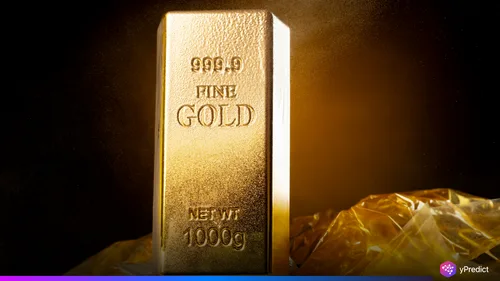
Gold prices fell on Friday as a stronger dollar priced out overseas demand while investors waited on U.S. Federal Reserve Chair Jerome Powell’s highly-anticipated address at the annual Jackson Hole symposium. With markets in turmoil over reviewing monetary policy, this afternoon’s address was particularly important for both the currencies and commodities space.
The precious metal faced selling pressure following the U.S. dollar index moving toward a two-week high and pricing offshore interest lower. That said traders were cautious because Powell’s speech was expected to provide fresh signals about whether the Fed is prepared to hint toward a rate cut next month. Markets were currently pricing a high probability of a policy shift, while recent Fed commentary suggests some hesitancy over initiating a cut.
The market’s focus on Jackson Hole underscores the uncertainty faced by global investors. We saw evidence of softening in the U.S. labor market while inflation is still elevated. Gold prices remained stuck moving sideways not knowing how to navigate the competing risks of recession and price pressure.
Dollar Strength Weighs on Gold Demand
Gold’s spot price drifted down 0.30% to $3,329.19 an ounce at the outset, while U.S. gold futures for December delivery were down to $3,372.10. The increase in the U.S. dollar index weighed on near-term demand for gold as it made the metal more expensive compared to a weaker dollar.
Research analysts observed that dollar movements typically dominate short-term price variations in gold. Tim Waterer, chief market analyst at KCM Trade, indicated that the more optimistic view on the U.S. currency, even in the presence of geopolitical tensions, created headwinds for gold. Waterer explained that while the Russia-Ukraine situation is ongoing, the potential for peace talks slightly dampened sentiment.
However, Powell’s dovish signals would suggest a dollar decline, which would offer renewed support to gold prices. Market participants remained alert, and set to react quickly to any changes in tone from Powell’s address.
Markets Eye Powell’s Jackson Hole Remarks
The Powell speech at Jackson Hole has become the centerpiece for traders looking for signals regarding monetary policy. This week, Fed officials voiced caution on cutting rates too soon, but futures markets are pricing in a 75% chance of a quarter-point cut next month.
Therefore, labor market data has added fuel to the debate. Jobless claims last week rose to their highest level in almost three months while the previous week’s unemployment claims had reached their highest level in four years. These data points signaled cracks within the U.S. labor market which supports a dovish argument toward policy easing.
However, inflation remains sticky. The Fed remains concerned that aggressive tariff increases could reignite price pressures which is creating unnecessary uncertainty in the decision-making process. For gold, which does well during uncertain economic times, this policy ambiguity will keep investor demand alive, even with periods of short-term weakness.
Broader Precious Metals Market Sees Mixed Moves
The weakness in gold prices also had a ripple effect on other metals. Spot silver fell 0.4 per cent to $38.01 per ounce, while platinum slid 0.6 per cent to $1,345.06. Only palladium showed any gains, rising 0.2 per cent to $1,113.19.
The mixed performance reflected a shift is investor sentiment as traders weighed economic date with data, central bank policy and geopolitical headlines. While silver and platinum have a tendency to follow gold prices palladium is influenced more by industrial demand, particularly automotive, than by gold prices.
Geopolitical Backdrop Adds More Uncertainty
In addition to U.S. monetary policy, state change was also an influencing factor on trading sentiment. That is to say that, according to news reports, Vladimir Putin (the President of Russian), was demanding major concessions from Ukraine including the Donbas region and no more NATO ambitions. These demands indicate continued uncertainties and instability in Eastern Europe which can lead to a rise in demand for gold as a safe haven.
Initial attempts of negotiation that signal a potential peace agreement could cause some decline in geopolitical risk; however, there is high uncertainty. More investors rotate to gold during conflict but the influence of a stronger dollar lowered the safe haven demand for gold.
Investor Outlook for Gold Prices
In looking into the future, the course for the gold price primarily depends on Powell. If Powell issues a dovish message, the combination of a weaker dollar could rally gold, however a hawkish message could contribute to a deeper selloff of the yellow metal. In the near term, investors are undecided, some argue there is slack in labor conditions that could allow the Fed to pivot toward rate cuts and higher prices for gold.
Others expect that any upside inflation risks could lead to the Fed playing it safe and maintaining the dollar’s strength, ultimately limiting any gains in the metals. At this point, traders are waiting as Friday’s event in Jackson Hole will carry considerable weight in the near term outlook for gold.







